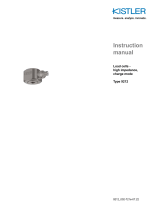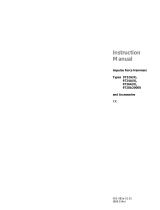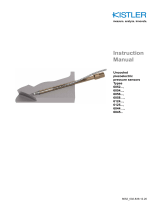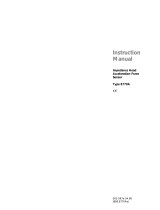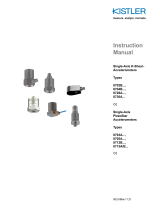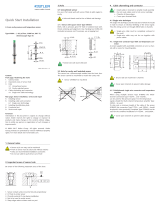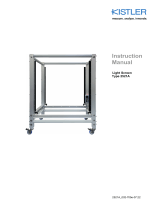Page is loading ...

Instruction
manual
Pencil probe
Type 6233B…
for blast pressure
measurement
6233B_002-708e-07.22


Foreword
6233B_002-708e-07.22 Page 1
Foreword
Thank you for choosing a Kistler quality product
characterized by technical innovation, precision and long
life.
Information in this document is subject to change without
notice. Kistler reserves the right to change or improve its
products and make changes in the content without
obligation to notify any person or organization of such
changes or improvements.
© 2015 … 2020 Kistler Group. All rights reserved. Except
as expressly provided herein, no part of this manual may
be reproduced for any purpose without the express prior
written consent of Kistler Group.
Kistler Group
Eulachstrasse 22
8408 Winterthur
Switzerland
Tel. +41 52 224 11 11
info@kistler.com
www.kistler.com

Pencil probe Type 6233B…
Page 2 6233B_002-708e-07.22
Content
1.
Introduction .................................................................................................................................. 3
2.
Important information ................................................................................................................. 4
2.1
Warranty .............................................................................................................................. 4
2.2
Disposal instructions for electrical and electronic equipment ............................................. 4
3.
Sensor .......................................................................................................................................... 5
3.1
General functional description............................................................................................. 5
3.2
Application in air blast testing.............................................................................................. 6
3.3
Measuring chain .................................................................................................................. 6
3.4
Triggering methods ............................................................................................................. 7
3.4.1
Low current wire around explosive charge ............................................................. 8
3.5
Bandwidth optimization ....................................................................................................... 9
3.5.1
Natural frequency of sensor ................................................................................... 9
3.5.2
Sensor diameter and propagation velocity of blast wave ....................................... 9
3.5.3
Cable length and excitation current ...................................................................... 10
3.5.4
Coupler bandwidth ............................................................................................... 11
3.5.5
Sampling frequency of DAQ system .................................................................... 11
4.
Installation and operation ......................................................................................................... 12
4.1
General measurement setup ............................................................................................. 12
4.1.1
Distance from explosive charge ........................................................................... 13
4.1.2
Height above ground ............................................................................................ 13
4.1.3
Distance from obstacles ....................................................................................... 14
4.2
Sensor setup ..................................................................................................................... 14
4.2.1
Functional check .................................................................................................. 14
4.2.1.1
Check IEPE amplifier circuit using hand-held power supply / coupler
Type 5114 ............................................................................................. 15
4.2.1.2
Check measuring chain by lead burst test on sensor ........................... 15
4.2.1.3
Check measuring chain by small explosive charge .............................. 16
4.2.2
Orientation ............................................................................................................ 16
4.2.3
Fixation ................................................................................................................. 16
4.2.3.1
Tripod adapter Type 6550A10 .............................................................. 18
4.2.3.2
Pipe adapter Type 6550A20 ................................................................. 19
4.2.4
Thermal shock protection ..................................................................................... 22
4.2.4.1
Thermal protection foil Type 1191AAA10 ............................................. 22
4.3
Cable connections ............................................................................................................. 23
4.4
Coupler settings ................................................................................................................ 23
4.5
Triggering .......................................................................................................................... 24
4.5.1
Trigger box type 2525A04 .................................................................................... 24
5.
Maintenance and calibration .................................................................................................... 26
5.1
Maintenance ...................................................................................................................... 26
5.1.1
Sensor .................................................................................................................. 26
5.1.2
Storage case Z21537 ........................................................................................... 26
5.2
Calibration ......................................................................................................................... 27
Total pages 27

Introduction
6233B_002-708e-07.22 Page 3
1. Introduction
Please take the time to thoroughly read this instruction
manual. It will help you with the installation, maintenance,
and use of this product.
To the extent permitted by law Kistler does not accept
any liability if this instruction manual is not followed or
products other than those listed under Accessories are
used.
Kistler offers a wide range of products for use in
measuring technology:
Piezoelectric sensors for measuring force, torque,
strain, pressure, acceleration, shock, vibration and
acoustic-emission
Strain gage sensor systems for measuring force and
torque
Piezoresistive pressure sensors and transmitters
Signal conditioners, indicators and calibrators
Electronic control and monitoring systems as well as
software for specific measurement applications
Data transmission modules (telemetry)
Kistler also develops and produces measuring solutions
for the application fields engines, vehicles, manufac-
turing, plastics and biomechanics sectors.
Our product and application brochures will provide you
with an overview of our product range. Detailed data
sheets are available for almost all products.
If you need additional help beyond what can be found
either on-line or in this manual, please contact Kistler's
extensive support organization.

Pencil probe Type 6233B…
Page 4 6233B_002-708e-07.22
2. Important information
2.1 Warranty
The equipment supplied by Kistler Instrumente AG
Winterthur is covered by a warranty against faulty
material and workmanship.
This warranty extends 12 months from delivery date.
When submitting warranty claims, the items of equipment
concerned are to be delivered to the manufacturer's
works or to the regional distributor free of all charges,
and full details should be stated as to the nature of the
claims.
Settlement of warranty claims may be effected, at the
manufacturer's discretion, either through reconditioning
or replacement of the faulty items, or through a credit
note to their value.
Items of equipment damaged as a result of improper use
are not covered by the warranty.
Our responsibility under the warranty is strictly restricted
to the above provisions and we specifically decline any
liability for damages incurred consequent upon the use or
operation of our equipment.
Warranty claims for blast pressure sensors:
Due to the destructive nature of blast testing, warranty
claims for blast pressure sensors must be clarified on a
case-by-case basis.
2.2 Disposal instructions for electrical and electronic equipment
Do not discard old electronic instruments in municipal
trash. For disposal at end of life, please return this
product to an authorized local electronic waste
disposal service or contact the nearest Kistler
Instrument sales office for return instructions.

Sensor
6233B_002-708e-07.22 Page 5
3. Sensor
The Type 6233B… pencil probes are designed to
measure highly dynamic pressures in air blast testing. An
integrated amplifier circuit (IEPE) converts the charge
signal from the quartz sensing elements into a voltage
output. This allows driving of long cables up to several
hundred meters of length. The sensing element is aligned
to measure the side-on pressure of the blast wave
passing across the sensor body.
Distinguished characteristics are:
Rise time <1 μs
High natural frequency >300 kHz
Voltage output (IEPE): integrated Piezotron
electronics
Acceleration compensated
Minimal bending sensitivity
Fig. 1: Pencil probe Type 6233B…
For full sensor specifications please refer to the data
sheet.
3.1 General functional description
Piezoelectric technology is ideally suited to measure
highly dynamic pressure signals over a wide range of
pressures. Pencil probe Type 6233B… is available with
measuring ranges from 0 … 25 psi, 50 psi, 250 psi, 500
psi and 1 000 psi. The characteristic pencil shape
minimizes the influence of the sensor geometry on the
blast wave propagation and the measured pressure
signal. Type 6233B… is pointed radially at the center of
the explosion or orthogonally to the blast wave. It
measures the side-on pressure of the propagating blast
wave.
The pencil body is made of corrosion-resistant, anodized
aluminum. A stiffer, stainless steel housing protects the
sensing element from mechanical deformations of the
pencil body which minimizes the sensitivity to bending

Pencil probe Type 6233B…
Page 6 6233B_002-708e-07.22
and ground shock effects. In the highly dynamic setting of
a blast test, the acceleration compensation of the sensing
element additionally avoids erroneous signals caused by
vibrations. The effects of thermal shock are small and
may be minimized further by applying a thermal
protection foil on the sensor membrane (refer to
Section 4.2.4 of this manual).
3.2 Application in air blast testing
Pencil type blast sensors are most effectively used in
testing scenarios where the direction of shock wave
propagation is clearly defined. In a side-on configuration,
the measurement is least affected by perturbations of the
pressure wave on the sensor. Side-on pressure is also
referred to as incident or static overpressure. A typical
use case is the free-field blast test, which aims at
characterizing the physical effects of an explosive
charge. Pencil probes are also used in blast impact
scenarios, where the destructive effects of explosions on
a protective structure are studied. These applications
also include testing of industrial safety technology.
Fig. 2: Visualization of free-field blast test setup
3.3 Measuring chain
The Type 6233B… pencil probes have a built-in charge
amplifier circuit and voltage signal output (IEPE:
Integrated Electronics Piezo Electric). Thus, no additional

Sensor
6233B_002-708e-07.22 Page 7
charge amplifier is required. The same technology is
referred to by the registered trademarks Piezotron
1
and
ICP
2
. A coupler provides the current needed to drive the
IEPE circuit and decouples the signal from the bias
voltage. This coupler may be a standalone unit or
integrated into the amplifier module of a data acquisition
(DAQ) system.
Fig. 3: Typical IEPE measuring chains
Standard coaxial cables with a BNC positive connector
configuration are used to connect the pencil probe to the
IEPE coupler and / or DAQ system. Kistler cable Type
1601B… is recommended.
If a standalone coupler is used, any high-speed DAQ
system / transient recorder may be used to digitize and
record the voltage signals. A number of commercial DAQ
systems include the option of IEPE coupling in the
amplifier modules. In this case, an external coupler is not
needed.
3.4 Triggering methods
Triggering of the data acquisition may be achieved by
multiple methods:
Low-current wire around explosive charge:
Explosion breaks the wire and stops the current. The
trigger time is defined by the physical expansion of
the explosive charge.
Flash detector:
Measuring device detects infrared emission of the
explosion. The trigger time is defined by the
progression of the fire ball and its light emission.
1
Piezotron is a registered trademark of Kistler Holding AG.
2
ICP is a registered trademark of PCB Piezotronics, Inc.

Pencil probe Type 6233B…
Page 8 6233B_002-708e-07.22
Pressure sensor:
Measurement is triggered by pressure sensor. The
trigger time is defined by the pressure rise caused by
the arrival of the blast wave. The original detonation
time point is not recorded.
Detonator:
Detonator device simultaneously produces high
voltage signal to ignite explosives and low voltage
signal to trigger measurement. The trigger time is
defined by the ignition signal. There may be a random
delay to the actual explosion.
DAQ system:
Combined measurement and detonator system
simultaneously produces high voltage signal to ignite
explosives and starts measurement. The trigger time
is defined by the ignition signal. There may be a
random delay to the actual explosion.
Kistler recommends using the first method as described
in the next section.
3.4.1 Low current wire around explosive charge
A trigger wire with a low current is placed around the
explosive charge. Upon detonation, the wire is destroyed
and the trigger signal generator produces a voltage step.
Fig. 4: Scheme of recommended triggering method:
low-current wire around explosive charge
This method combines the following advantages:
Safety:
Measuring chain is electrically decoupled from the
detonation chain.

Sensor
6233B_002-708e-07.22 Page 9
Trigger time:
The trigger time very closely represents the
detonation time point. This is important to analyze the
propagation velocity of the blast wave (time of arrival).
Other methods may not account for delays between
the detonator signal and the detonation time, or may
not record the detonation time at all.
For simple and safe triggering of blast measurements,
Kistler recommends using trigger box Type 2525A04
(refer to Section 4.5.1 of this manual).
3.5 Bandwidth optimization
To determine the true bandwidth of the measurement
setup, it is not sufficient to know the natural frequency of
the sensor itself. Along the entire measuring chain, the
following factors influence the overall bandwidth:
Natural frequency of sensor
Sensor diameter and propagation velocity of blast
wave
Cable length and excitation current
Coupler bandwidth
Sampling frequency of DAQ system
In the following sections, these factors are described in
more detail.
3.5.1 Natural frequency of sensor
The natural frequency is an inherent parameter of each
sensor type and cannot be influenced by the user. It
represents the frequency at which the sensor is excited
to resonance. For pencil probe Type 6233B… it has the
following value:
Natural frequency f
N
300 kHz
3.5.2 Sensor diameter and propagation velocity of blast wave
In the side-on measurement configuration, it takes some
time for the blast wave to travel across the sensor
membrane. The full signal is only measured once the
entire membrane is subjected to the pressure.

Pencil probe Type 6233B…
Page 10 6233B_002-708e-07.22
Fig. 5: Schematic of blast wave traveling across
sensor membrane.
The resulting low-pass filtering effect depends on the
sensor diameter and the propagation velocity of the blast
wave.
Example:
Side-on pressure p = 10 bar (145 psi)
Velocity of blast wave v = 1000 m/s
Diameter D = 5.5 mm
Δt = 5.5 µs
Maximum frequency
kHz
s
f180
5.5
1
max
3.5.3 Cable length and excitation current
In order to avoid damage of the electronic instruments by
the blast, the coupler and DAQ system have to be placed
at a safe distance from the blast site. On the other hand,
the cable length has to be minimized to achieve
maximum signal dynamics.
Any cable has an inherent capacitance and acts as a
low-pass filter. The maximum frequency can be
estimated using the following equation:
2100
10
2
10
9
max
9
max
VL
m
pF
I
f
VC
I
f
f
max
= maximum frequency [Hz]
I = excitation current supplied by IEPE coupler [mA]
C = cable capacitance [pF]
L = cable length [m]
V = maximum signal amplitude [V]

Sensor
6233B_002-708e-07.22 Page 11
Example:
Signal amplitude V = 2.9 V
Cable capacity C = 100 pF/m
Cable length L = 100 m
Excitation current I = 4 mA → f
max
= 22 kHz
I = 8 mA → f
max
= 44 kHz
Thus, there are several ways to increase the maximum
frequency:
Minimize cable length:
Optimize blast setup to minimize cable lengths. For
large-scale tests, use multiple synchronized transient
recorders / autonomous measuring systems.
Increase excitation current:
Excitation currents up to 20 mA are applicable for
pencil probe Type 6233B. However, at high excitation
currents the sensor heats up considerably which may
reduce the lifetime.
Decrease signal amplitude:
The signal amplitude can be decreased by using a
pencil probe with less sensitivity / higher pressure
range. Of course, the better dynamics are traded
against a loss in pressure resolution.
Minimize cable capacitance:
By using high quality coaxial cables, the cable
capacitance may be reduced to around 100 pF/m.
Due to technical reasons, further minimization of the
cable capacitance is not possible.
3.5.4 Coupler bandwidth
The IEPE coupler used has its own limitation in
bandwidth, which should be stated on the data sheet.
This also applies for DAQ systems with built-in IEPE
coupling. Although the maximum sampling frequency of
the DAQ system may be very high, the lower bandwidth
of the coupler may limit the achievable dynamics.
3.5.5 Sampling frequency of DAQ system
DAQ systems used to record highly dynamic blast
pressure events should fulfill the following minimum
specification:
Sampling frequency f
s
1 MSa/s
According to the Nyquist-Shannon sampling theorem, the
achievable maximum frequency that can be
reconstructed without loss of information is:
f
max
= f
s
/ 2

Pencil probe Type 6233B…
Page 12 6233B_002-708e-07.22
4. Installation and operation
4.1 General measurement setup
The pencil probe must be aligned in radial direction to the
center of the blast and ideally on the same height as the
explosive charge.
Fig. 6: Example of mounting setup
Blast propagation physics have to be taken into
consideration to define a suitable test setup. If the pencil
probe is positioned very close to the explosive charge,
only the primary blast wave is measured. Further away,
there are several pressure peaks of primary and reflected
waves. After a certain distance, only one high peak of
superimposed waves is seen (Mach stem).
The integral of the positive pressure curve is referred to
as impulse.
Fig. 7: Physics of blast wave propagation

Installation and operation
6233B_002-708e-07.22 Page 13
4.1.1 Distance from explosive charge
The following factors need to be considered to define the
best distance from the explosive charge:
Ground reflections:
For improved interpretation of measurement results,
superpositions of ground reflections and other
secondary blast waves should be minimized as much
as possible. Depending on the height above ground,
the pencil probe should be placed close enough to the
explosive charge so as to only measure the primary
blast wave. The same principle applies with respect to
the distance from other obstacles than the ground. In
many cases, however, superpositions cannot be
avoided or need to be studied explicitly.
Propagation velocity of blast wave:
Several pencil probes may be placed in a row with
respect to the center of the explosion in order to easily
determine the velocity of blast wave propagation.
Damage by debris:
Depending on the type of explosive charge and the
quality of the surrounding ground, the pencil probe
should be placed far enough away from the
detonation in order not be damaged by debris (rocks,
wood splinters, shrapnel).
Pressure overload:
The maximum pressure felt by the pencil probe must
not exceed the specified overload pressure of
5000 psi (350 bar). Mathematical models or
preliminary blast measurements at a safe distance
may be used to estimate the maximum pressure at
close distance.
In most applications, it is not possible to optimize all of
these factors. The required quality of the measured
signals must be weighed against the risk of causing
damage to the sensors.
Multiple pencil probes mounted at equal distances from
the explosive charge do not necessarily measure equal
pressure amplitudes. There are always asymmetric
effects in the chemical reaction of the explosion.
4.1.2 Height above ground
The following factors need to be considered to define the
best height above ground:
Ground reflections:
For improved interpretation of measurement results,
superpositions of ground reflections and other
secondary blast waves should be minimized as much

Pencil probe Type 6233B…
Page 14 6233B_002-708e-07.22
as possible. Depending on the distance from the
explosive charge, the pencil probe should be placed
high enough above ground so as to only measure the
primary blast wave.
Stability of fixation:
Mobile pencil probe fixations such as tripods cannot
be arbitrarily high due to the risk of falling over due to
the blast wave. The stability of a tripod may be
improved by weighing it down, for example by a
sandbag.
4.1.3 Distance from obstacles
In indoor blast tests or blast impact scenarios, additional
considerations have to be taken with respect to obstacles
such as walls, vehicles or other objects.
Reflections:
For improved interpretation of measurement results,
superpositions of reflected secondary blast waves
should be minimized as much as possible. The pencil
probes should be placed far enough from any
obstacles so as to only measure the primary blast
wave.
4.2 Sensor setup
4.2.1 Functional check
Due to the destructive nature and high costs of blast
testing, functional checking of all measuring chains is
highly recommended prior to any detonation. There are
multiple options to perform a functional check:
Hand-held coupler Type 5114: check
Sensor (IEPE circuit) + cabling
Lead burst test: check
Sensor + cabling + coupler + DAQ
(1 channel at a time)
Small explosive charge: check
Sensors + cabling + couplers + DAQ + trigger
(all channels simultaneously)
In the following sections, these methods are described in
more detail.

Installation and operation
6233B_002-708e-07.22 Page 15
4.2.1.1 Check IEPE amplifier circuit using hand-held power supply / coupler Type 5114
To check the proper functioning of the integrated IEPE
electronics, the hand-held Power supply / Coupler
Type 5114 may be used. This test may be done using the
real cable length of the final setup.
Please refer to the instruction manual of Type 5114 for
detailed operating instructions.
Fig. 8: Hand-held Kistler power supply / coupler Type
5114
4.2.1.2 Check measuring chain by lead burst test on sensor
A functional check of the entire measuring chain can be
done by breaking a thin lead pencil mine on the sensor
membrane. This is a well-known method used in the
characterization of piezoelectric sensors, because it
generates a very dynamic signal. The recommended
diameter of the lead mine is 0.5 mm and the length
approximately 5 mm.
Fig. 9: Commercial pencil used for lead burst test
and example of signal

Pencil probe Type 6233B…
Page 16 6233B_002-708e-07.22
4.2.1.3 Check measuring chain by small explosive charge
Prior to a large scale explosive test, it is recommended to
perform a small scale life detonation to check the proper
functioning of all measuring chains in the final
measurement setup. An explosive charge containing a
small fraction of the explosives of the actual charge is
used to generate a small blast wave which triggers a
measurement. The resulting signals can be checked for
malfunctions in the measuring chains.
4.2.2 Orientation
In order to avoid direct exposure to ground reflections,
the pencil probe has to be set up with the sensing
element facing up, away from the ground.
Fig. 10: Orientation of pencil probe: sensor (blue dot)
facing up
4.2.3 Fixation
The pencil probe fixation serves multiple purposes during
a blast measurement:
Alignment:
The fixation helps to accurately point the pencil probe
towards the center of the explosion during the initial
arrival of the blast pressure wave. Proper alignment is
critical to obtain the correct peak pressure and should
be within an angle of ±5° of the radial direction.
Stable fixation:
The primary blast wave and its reflected waves exert
considerable force on the fixation. If the sensor is
pushed out of the fixation or the entire setup falls
over, this may result in damage of the sensor
membrane, pencil tip or cable connector.

Installation and operation
6233B_002-708e-07.22 Page 17
Mechanical damping:
Excessive ground shock may induce a signal
superimposed on the pressure signal. Since the
ground wave travels faster than the pressure wave in
the air, a noisy signal is commonly seen shortly before
arrival of the blast wave. The fixation needs to provide
mechanical damping to minimize the effects of ground
shock.
Two standard fixation types are recommended:
Tripod fixation
Pipe fixation

Pencil probe Type 6233B…
Page 18 6233B_002-708e-07.22
4.2.3.1 Tripod adapter Type 6550A10
For pressure impulses <1 000 mbar*ms (see section 4.1)
the pencil probe can be installed on a standard tripod.
Such an installation is most convenient for mobile use
and variable test setups. It may be used equally on level
and rough surfaces.
The Kistler tripod adapter Type 6550A10 features a
standard ¼-inch UNC thread (DIN4503 / ISO1222),
which is compatible with most commercial tripods used
for example in photography. It is recommended to attach
the tripod adapter at the rear end of the pencil probe in
order to delay any pressure reflections.
Fig. 11: Attachment of tripod adapter Type 6550A10 at
rear end of pencil probe
To prevent tipping of the tripod, it should be stabilized, for
example by a sand bag.
Fig. 12: Tripod installation including stabilization with
sand bag
/
